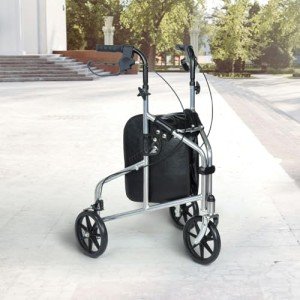
Affordable Rollator
Add a review FollowOverview
-
Founded Date Aprile 11, 1999
-
Sectors Sales & Marketing
-
Posted Jobs 0
-
Viewed 118
Company Description
The Comprehensive Guide To How To Use A Rollator
How To Use A Rollator: A Comprehensive Guide
Rollators are mobility aids developed to improve the independence and safety of people with mobility obstacles. Unlike standard walkers, rollators are equipped with wheels, a seat, and often a storage pouch, enabling users to move with greater ease and convenience. This short article supplies a thorough guide on how to use a rollator efficiently and securely, making sure a smoother and more satisfying walking experience.
What is a Rollator?
A rollator is a wheeled walking aid. It usually has:
- Three or 4 wheels: Offering stability and maneuverability.
- Hand brakes: For control while walking or when resting.
- A seat: Allowing users to take breaks conveniently.
- Storage space: Such as a basket or pouch for individual items.
Types of Rollators
There are numerous types of rollators, created to satisfy the needs of different users:
| Type | Description | Best for |
|---|---|---|
| OasisSpace 3-Wheel Foldable Walker – Easy Mobility Rollator | Lighter and more compact, ideal for indoor use | Navigating tight areas |
| 4-Wheel Rollator | Offers stability and a larger seat, appropriate for outdoor use | Longer strolls and much heavier use |
| Sturdy Rollator | Developed to support more weight with extra robust functions | Users needing extra assistance |
| Pediatric Rollator | Smaller sized in size, changed for children | Children with mobility restrictions |
How to Use a Rollator
Utilizing a rollator correctly is essential to guarantee safety and take full advantage of the benefits it provides. Here’s a detailed guide:
Step 1: Adjust the Height
Before using the rollator, it is important to adjust the handlebars to the correct height.
- Stand straight: With your arms relaxed at your sides.
- Measure the height: The hand grips need to be at wrist level when the user is standing.
- Safe changes: Ensure all locking systems are firmly engaged.
Action 2: Familiarize Yourself with the Rollator
Comprehending the elements of the rollator will help improve its use.

- Brakes: Learn how to engage and release the brakes by squeezing the manages.
- Seat: Identify where to sit easily when you require to rest.
- Storage location: Know where you can keep personal possessions.
Step 3: Start Walking
- Position the rollator: Place it a step ahead of you, guaranteeing that the brakes are released.
- Grip the deals with securely: Keep a light tension in your arms while holding onto the rollator.
- Step inside the frame: Move forward by stepping with one foot and then the other.
- Preserve a straight posture: Walking should be upright, preventing the temptation to lean on the rollator exceedingly.
Step 4: Utilize Brakes
Always use the brakes effectively to boost safety:
- To decrease: Gradually squeeze the brakes.
- To stop: Fully engage the brakes by pulling on both handles.
- To take a seat: Ensure the rollator is steady, then carefully lower yourself onto the seat.
Step 5: Maneuver with Care
Turning and browsing can be tough, so here are essential ideas:
- Telegraph your instructions: Look where you wish to go before turning.
- Take small steps: Move gently when turning to maintain balance.
- Use a three-point turn: Turn from one side to the other, keeping the walker close.
Action 6: Practice Stopping and Resting
Taking breaks is vital. Here are suggestions for resting:
- Find flat surfaces: Ensure the area is level when you sit.
- Engage the brakes when seated: This will avoid rolling.
- Shift position slowly: When ready to stand once again, get rid of the brakes before rising.
Maintenance and Safety Tips
To make sure the rollator stays functional and safe:
- Regularly examine the brakes: Ensure they engage and launch correctly.
- Examine wheel positioning: Wheels must not wobble; tighten up any loose screws.
- Tidy the rollator: Wipe down surface areas and get rid of debris from tires to keep smooth operation.
Common Concerns
Users might deal with a number of typical problems when utilizing rollators. Here are some basic FAQs:
FAQs
Q1: Can I use a rollator outdoors?A: Yes, a lot of
rollators are designed for both indoor and outdoor use. However, ensure it has the suitable wheel size and tread for outdoor surfaces. Q2: What are the weight limits on rollators?A: Weight limits
typically vary by model, however heavy-duty rollators can usually accommodate users weighing around 300 to 500 pounds. Q3: Are rollators adjustable?A: Yes, a lot of rollators include adjustable deal with heights to accommodate users of various heights
. Q4: How do I transfer a rollator?A: Many rollators canbe folded for hassle-free transportation in an automobile. Always examine the user handbook for specific folding instructions. Q5: Can I use a rollator while recovering from surgery?A: Yes, numerous individuals use rollators during healing to restore strength and balance, but ensure you follow your health care company’s suggestions.
Comprehending how to use a rollator properly can substantially enhance mobility and decrease the threat of falls. Whether you are new to using mobility aids or aiming to improve your technique, following the guidelines discussed in this article is crucial. With practice, a rollator can enhance self-reliance while guaranteeing safety, hence allowing users to take pleasure in a more active way of life.


